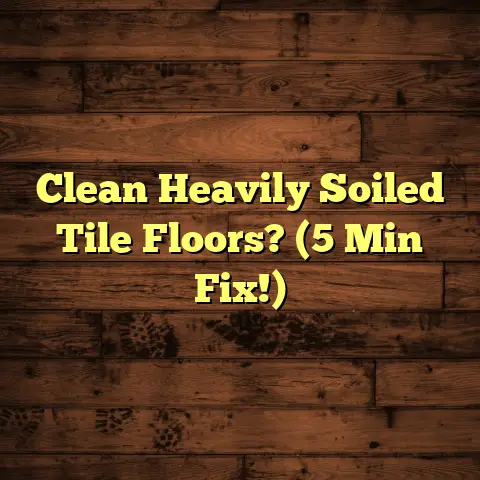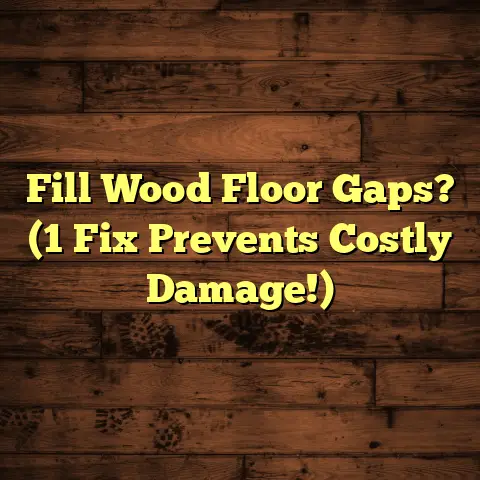Removing Shower Tile Floor: Easy? (2 Tools Needed)
Bathrooms have really transformed, haven’t they? They’re not just a place to get clean anymore. Now, they’re like a mini-spa, a place to relax and unwind.
And tile? Tile is king (or queen!) when it comes to modern bathrooms, especially in the shower. It’s durable, comes in a million styles, and can totally change the vibe of your bathroom.
From sleek, minimalist vibes to bold, eclectic statements, tile flooring is where it’s at. But, let’s be real, sometimes that tile needs to go. Whether it’s outdated, damaged, or just not your style anymore, tile removal is something many homeowners face.
So, is it easy? Can you really do it with just two tools? Let’s dive in and find out. I’ll share my experiences and give you the lowdown on DIY tile removal.
Section 1: Understanding the Tile Removal Process
1.1 The Importance of Proper Tile Removal
Okay, so you’re thinking about ripping out that old shower tile. Awesome! But before you grab a hammer and go to town, let’s talk about why proper removal is so important.
I’ve seen so many DIY projects go sideways because people skip this step. The biggest reason is structural damage. If you’re too rough, you can damage the subfloor underneath. This means more work, more money, and a bigger headache down the road.
Think about it – that subfloor is the foundation for everything. Mess it up, and your new tile won’t sit right, you might have leaks, or even worse.
Plus, there’s the whole safety aspect. Chipping away at tile can send shards flying. Dust can get everywhere. Trust me, you want to protect yourself and your bathroom.
Now, why do people remove tile in the first place? Well, there are tons of reasons. Maybe your tile is seriously outdated. Avocado green, anyone?
Or maybe you’ve got water damage creeping in. Cracked tiles, moldy grout – these are all signs it’s time for a change. And sometimes, you just want a new look!
1.2 Overview of Shower Tile Types
Let’s talk tile! Not all tiles are created equal, and knowing what you’re dealing with will make the removal process much smoother. Here’s a quick rundown of common shower tile types:
-
Ceramic: This is probably the most common. It’s affordable, durable, and comes in tons of styles. Ceramic is generally easier to remove than some other types.
-
Porcelain: Similar to ceramic, but denser and more water-resistant. Porcelain is a great choice for showers, but it can be a bit tougher to remove because it’s so strong.
-
Glass: Glass tiles can add a really stylish touch to a shower. They’re non-porous and easy to clean. However, they can be brittle and require a delicate touch during removal.
-
Stone: Think natural stone like slate, marble, or travertine. Stone tiles are beautiful and add a luxurious feel. They can be porous, so they need to be sealed properly. Removing stone tile can be tricky, as some types are more prone to chipping and cracking.
The type of tile definitely impacts the removal process. For example, a thin glass tile will behave differently than a thick porcelain tile. The adhesive used also plays a big role. Some adhesives are super strong and require more effort to break down.
Section 2: Tools Needed for Tile Removal
Okay, time to gear up! The big question is, can you really remove shower tile with just two tools? Well, technically, yes. But I’m going to give you the core essentials, and we can talk about some helpful extras later.
2.1 Tool 1: The Floor Scraper
First up, we have the floor scraper. This is your workhorse for getting under those tiles and popping them loose.
A floor scraper is basically a long handle with a wide, flat blade at the end. The blade is usually made of hardened steel, so it can withstand some serious force. You use it by sliding the blade under the edge of the tile and using leverage to pry it up.
When you’re choosing a floor scraper, look for one with a comfortable handle. You’ll be putting some elbow grease into this, so you want something that won’t kill your hands.
Also, consider the blade width. A wider blade can cover more surface area, but it might be harder to maneuver in tight spaces. A narrower blade is more precise, but it’ll take longer to get the job done.
I’d recommend a scraper with an angled head. This makes it easier to get under the tile without having to bend over too much. Your back will thank you!
2.2 Tool 2: The Hammer and Chisel
Next, we have the dynamic duo: the hammer and chisel. These guys are your demolition crew. They’re perfect for breaking up stubborn tiles and getting into those hard-to-reach spots.
The chisel is a metal tool with a beveled edge that you place against the tile. Then, you whack it with the hammer to break the tile or loosen it from the adhesive.
For tile removal, you’ll want a cold chisel. These are made of hardened steel and can withstand repeated hammering. Look for one with a comfortable grip to protect your hands.
Now, let’s talk technique. The key is to use controlled force. You don’t want to swing the hammer like you’re trying to knock down a wall. Start with gentle taps and gradually increase the force as needed.
Always wear safety glasses when using a hammer and chisel. Tile shards can fly everywhere, and you don’t want to risk an eye injury. Also, consider wearing gloves to protect your hands from blisters.
Aim the chisel at the edges of the tile, where it meets the grout lines. This is usually the weakest point. Work your way around the tile, gradually loosening it from the adhesive.
Section 3: Step-by-Step Guide to Removing Shower Tile Floor
Alright, let’s get down to business! Here’s my step-by-step guide to removing shower tile floor using just a floor scraper, hammer and chisel.
3.1 Preparation Before Removal
Before you even think about swinging that hammer, you need to prep the area. This is crucial for safety and for protecting the rest of your bathroom.
-
Clear the Area: Remove everything from the shower. Shampoo bottles, shower curtains, anything that’s in the way needs to go.
-
Protect Surrounding Surfaces: Cover the shower walls and the bathroom floor with drop cloths or plastic sheeting. This will protect them from scratches, dust, and debris.
-
Gear Up: Safety first! Wear safety glasses to protect your eyes from flying tile shards. Wear gloves to protect your hands from blisters and cuts. And consider wearing a dust mask to avoid breathing in tile dust.
3.2 Step 1: Breaking the Grout
The grout is what holds the tiles together, so you need to break it down before you can start removing the tiles.
You can use a grout saw or a utility knife to score the grout lines. A grout saw is a special tool with a carbide blade that’s designed specifically for removing grout. A utility knife can also work, but it’ll take more time and effort.
Run the grout saw or utility knife along the grout lines, pressing firmly to cut through the grout. You don’t need to remove all of the grout, just weaken it enough so that you can break the tiles free.
3.3 Step 2: Loosening the Tiles
Now it’s time to bring in the floor scraper. Position the blade of the scraper at the edge of a tile, where it meets the grout line. Apply pressure and try to slide the blade underneath the tile.
Once you’ve got the blade under the tile, use leverage to pry it up. You might need to wiggle the scraper back and forth to loosen the tile from the adhesive.
If the tile is really stuck, try tapping the back of the scraper with a hammer to help it slide underneath. Be careful not to hit the tile directly, as this could cause it to crack.
3.4 Step 3: Removing the Tiles
For tiles that are particularly stubborn, you’ll need to use the hammer and chisel. Place the chisel at the edge of the tile, where it meets the grout line.
Tap the chisel with the hammer, using controlled force. The goal is to break the tile into smaller pieces that are easier to remove.
Work your way around the tile, gradually breaking it into smaller pieces. Be careful not to damage the subfloor underneath.
Once you’ve broken the tile into pieces, you can use the floor scraper to pry them up. You might need to use the chisel to scrape away any remaining adhesive.
3.5 Step 4: Cleaning Up
Once you’ve removed all of the tiles, it’s time to clean up the mess. This is an important step, as you don’t want to leave any debris or adhesive residue on the floor.
Use a shop vacuum to suck up all of the tile shards, dust, and debris. Then, scrape away any remaining adhesive with the floor scraper or a putty knife.
You might need to use a chemical adhesive remover to get rid of stubborn residue. Follow the instructions on the product label carefully.
Finally, wipe down the floor with a damp cloth to remove any remaining dust or residue. Now you’re ready to inspect the subfloor.
Section 4: Potential Challenges in Tile Removal
Okay, let’s be real. Tile removal isn’t always a walk in the park. Sometimes, you run into challenges that can make the process a bit more difficult.
4.1 Dealing with Stubborn Tiles
The biggest challenge I see is dealing with tiles that are just plain stubborn. Maybe they were installed with super-strong adhesive, or maybe they’ve been there for decades and are practically fused to the subfloor.
Here’s what I recommend when you encounter stubborn tiles:
-
Patience is Key: Don’t get frustrated and start wailing on the tile with a hammer. This is a recipe for disaster. Take your time and work slowly and methodically.
-
Heat it Up: Applying heat can help loosen the adhesive. You can use a heat gun or a hairdryer to warm up the tile. Be careful not to overheat the tile, as this could cause it to crack.
-
Try a Solvent: There are chemical solvents specifically designed to dissolve tile adhesive. Apply the solvent according to the instructions on the label. Be sure to ventilate the area properly, as these solvents can have strong fumes.
-
Score the Tile: Use a tile scorer to create a series of lines across the surface of the tile. This will weaken the tile and make it easier to break into smaller pieces.
4.2 Managing Dust and Debris
Tile removal is a messy job. It creates a lot of dust and debris, which can be a nuisance and a health hazard.
Here are some tips for managing dust and debris:
-
Seal Off the Area: Use plastic sheeting and painter’s tape to seal off the bathroom from the rest of your house. This will prevent dust from spreading to other rooms.
-
Use a Shop Vacuum: A shop vacuum is your best friend during tile removal. It’s much more powerful than a regular vacuum cleaner and can handle the large amount of dust and debris that you’ll be creating.
-
Wet the Tile: Lightly misting the tile with water before you start removing it can help reduce the amount of dust that’s generated.
-
Ventilate the Area: Open a window or turn on a fan to ventilate the bathroom. This will help remove dust and fumes from the air.
Section 5: After the Tile Removal
You’ve removed the tile. Now what? Don’t just slap down new flooring. There are a few important steps to take after the tile is gone.
5.1 Inspecting the Subfloor
This is crucial. The subfloor is the foundation for your new flooring, so you need to make sure it’s in good condition.
-
Look for Damage: Check for cracks, holes, or soft spots in the subfloor. These could be signs of water damage or structural problems.
-
Check for Moisture: Use a moisture meter to check the moisture level of the subfloor. If it’s too high, you’ll need to address the moisture issue before installing new flooring.
-
Repair Any Damage: If you find any damage to the subfloor, repair it before moving on. You might need to patch holes with wood filler or replace damaged sections of the subfloor.
5.2 Preparing for New Flooring
Once you’ve inspected and repaired the subfloor, it’s time to prepare it for the new flooring.
-
Clean the Subfloor: Remove any remaining adhesive, dust, or debris from the subfloor. You can use a scraper, a shop vacuum, and a damp cloth to clean the surface.
-
Level the Subfloor: Use a self-leveling compound to level any uneven areas of the subfloor. This will ensure that your new flooring sits flat and doesn’t have any bumps or dips.
-
Install a Moisture Barrier: If you’re installing a moisture-sensitive flooring material, such as laminate or hardwood, you’ll need to install a moisture barrier over the subfloor. This will protect the flooring from moisture damage.
Conclusion: Assessing the Ease of Tile Removal
So, back to the original question: Is removing shower tile flooring easy? Well, it depends.
Technically, yes, you can do it with just a floor scraper, hammer and chisel. But the actual ease of the process depends on a few factors:
-
Type of Tile: Softer tiles like ceramic are generally easier to remove than harder tiles like porcelain or stone.
-
Adhesive Strength: The type of adhesive used to install the tile will also affect how easy it is to remove. Some adhesives are super strong and require more effort to break down.
-
Your Skill Level: If you’re a seasoned DIYer with experience using hand tools, you’ll probably find tile removal to be relatively straightforward. But if you’re a complete beginner, it might be a bit more challenging.
In my experience, most homeowners can successfully remove shower tile flooring themselves with the right tools, preparation, and a bit of patience. But if you’re unsure about your abilities or encounter any major challenges, it’s always best to call in a professional.





